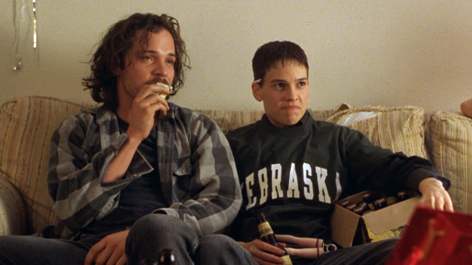
 A 1999 film dramatized the real life story of a transgender man in a small Nebraska town, and it is still powerful and relevant today.
A 1999 film dramatized the real life story of a transgender man in a small Nebraska town, and it is still powerful and relevant today.
In 1999, “transgender” wasn’t a well-known term, at least not in mainstream culture. That was the year a film called Boys Don’t Cry was released, directed by Kimberley Peirce, and written by Peirce and Andy Bienen. It dramatizes the real-life story of Teena Brandon, who changed her name to Brandon Teena and passed for a young man in a small Nebraska town.
The movie is beautifully crafted, with intensely vulnerable acting, and pervaded with feelings of longing and sadness. Over it all hangs a sense of menace, forebodings of the bad things that can happen when someone steps over the lines of gender. Peirce’s visual sense is dark and moody. From time to time the drama is punctuated with shots of clouds over the night prairie, flashes of electrical storms, set to the sounds of a mournful guitar.
The biggest success of Boys Don’t Cry lies in the performances Peirce gets from her actors. Hilary Swank is a remarkable Brandon—brilliant at showing the desperate need to belong as a man, with all the high risk-taking and on-the-edge quality that would imply for someone who was biologically a woman. Swank captures this lonely character, profoundly unaware of himself, without a long-range plan, just living for the next moment. It is not a gimmicky performance. You may recall that Swank won her first Oscar for this film.
Even so, I think the film might not have worked without the right actress to play Lana, the woman Brandon falls in love with. Chloë Sevigny is devastating in this part. Lana gradually falls for the young man, so different from the men she hangs out with, and Sevigny shows us her heart-wrenching transformation as the truth about Brandon comes out. It’s a deepening of character, so moving and so right, and in a way she represents a possible response to the challenge posed by Brandon, a response of love that stays true to itself against all odds, which is stirring, tragic and truthful.
Brandon’s journey is meaningful because it calls into question the whole cultural edifice of gender. The roles that we play in society, the qualities we exhibit and those we hide, the feelings we have about ourselves, are powerfully influenced by ideas of what it means to be male or female. The experience of Brandon is that the human spectrum is by necessity much wider than this narrow band which is imposed by our culture.
The film also demonstrates this through the characters of two young men, John and Tom, expertly played by Peter Sarsgaard and Brendan Sexton III. They’re hard-drinking and rebellious, full of swagger and violence. It’s tempting to distance ourselves and look at them as mere villains. Peirce undermines that temptation in subtle ways. There’s a scene where Tom deliberately puts his hand in a fire, and shows Brandon the marks where he’s cut himself. This is a perfect symbol for the way a man has had to deny and suppress his feelings, his capacity to be hurt or afraid or to grieve, in order to survive as a man. And at some level, tough guy John seems to sense denied aspects of himself in Brandon.
Peirce’s treatment of Brandon’s ultimate fate is unflinching. We are made to look squarely at the violence of retaliation. The movie can be a shattering experience to watch, but I think there was no other way for Peirce to present the full force and meaning of the story. 25 years later, Boys Don’t Cry retains a stunning urgency.

